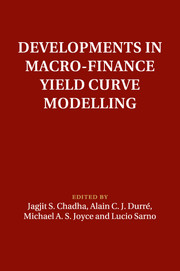Book contents
- Frontmatter
- Contents
- List of figures
- List of tables
- List of contributors
- Foreword
- Preface
- 1 Editors' introductory chapter and overview
- Part I Keynote addresses
- Part II New techniques
- Part III Policy
- 11 The repo and federal funds markets before, during, and emerging from the financial crisis
- 12 Taylor rule uncertainty: believe it or not
- Part IV Estimating inflation risk
- Part V Default risk
- Index
12 - Taylor rule uncertainty: believe it or not
from Part III - Policy
Published online by Cambridge University Press: 05 February 2014
- Frontmatter
- Contents
- List of figures
- List of tables
- List of contributors
- Foreword
- Preface
- 1 Editors' introductory chapter and overview
- Part I Keynote addresses
- Part II New techniques
- Part III Policy
- 11 The repo and federal funds markets before, during, and emerging from the financial crisis
- 12 Taylor rule uncertainty: believe it or not
- Part IV Estimating inflation risk
- Part V Default risk
- Index
Summary
“Not to be absolutely certain is, I think, one of the essential things in rationality.”
(Bertrand Russell in Am I An Atheist Or An Agnostic?)12.1 Introduction
This chapter studies agents' perception of US monetary policy from 1986 to 2011 by fitting expected Taylor rules to a unique dataset of macroeconomic forecasts. The use of subjective forecasts allows us to investigate the extent to which agents believe the Fed are following a given policy function, and to quantify the uncertainty associated with these beliefs. This is important since it allows us to study questions relating to the conduct of Central Bank policy. For example, in recent years Chairman Bernanke has vigorously supported the idea that announcements, if credible, can have the same effect as effective policy actions. This requires people to believe in the monetary rule that is used to anchor expectations. By estimating subjective expected Taylor rules, we provide a novel empirical identification scheme to address such questions.
Since at least the tenure of Chairman Volcker, it has generally been understood that US monetary policy is empirically well described by a Taylor (1993) rule (see, among others, Levin, Wieland, and Williams (2003)). Taylor rules are recipes that call for the adjustment of the policy instrument (the federal funds rate in the case of the US) in response to rising inflation and/or temporary deviations of output from its potential level (see Clarida, Gali, and Gertler (1999)).
- Type
- Chapter
- Information
- Developments in Macro-Finance Yield Curve Modelling , pp. 326 - 358Publisher: Cambridge University PressPrint publication year: 2014



